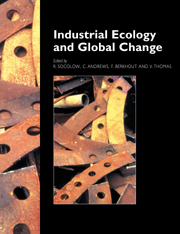Book contents
- Frontmatter
- Contents
- Foreword
- Preface
- Acknowledgments
- Contributors
- OVERVIEW
- PART 1 VULNERABILITY AND ADAPTATION
- PART 2 THE GRAND CYCLES: DISRUPTION AND REPAIR
- PART 3 TOXICS AND THE ENVIRONMENT
- 15 Introduction
- 16 Soil as a Vulnerable Environmental System
- 17 The Vulnerability of Biotic Diversity
- 18 Global Ecotoxicology: Management and Science
- 19 Industrial Activity and Metals Emissions
- 20 Metals Loading of the Environment: Cadmium in the Rhine Basin
- 21 Emissions and Exposure to Metals: Cadmium and Lead
- 22 Nuclear Power: An Industrial Ecology that Failed?
- PART 4 INDUSTRIAL ECOLOGY IN FIRMS
- PART 5 INDUSTRIAL ECOLOGY IN POLICY-MAKING
- END PIECE
- Organizing Committee Members
- Working Groups
- Index
16 - Soil as a Vulnerable Environmental System
Published online by Cambridge University Press: 04 August 2010
- Frontmatter
- Contents
- Foreword
- Preface
- Acknowledgments
- Contributors
- OVERVIEW
- PART 1 VULNERABILITY AND ADAPTATION
- PART 2 THE GRAND CYCLES: DISRUPTION AND REPAIR
- PART 3 TOXICS AND THE ENVIRONMENT
- 15 Introduction
- 16 Soil as a Vulnerable Environmental System
- 17 The Vulnerability of Biotic Diversity
- 18 Global Ecotoxicology: Management and Science
- 19 Industrial Activity and Metals Emissions
- 20 Metals Loading of the Environment: Cadmium in the Rhine Basin
- 21 Emissions and Exposure to Metals: Cadmium and Lead
- 22 Nuclear Power: An Industrial Ecology that Failed?
- PART 4 INDUSTRIAL ECOLOGY IN FIRMS
- PART 5 INDUSTRIAL ECOLOGY IN POLICY-MAKING
- END PIECE
- Organizing Committee Members
- Working Groups
- Index
Summary
Abstract
Since 1945, soil degradation has affected nearly 20% of the vegetated land area of the earth, with agriculture, overgrazing, and deforestation the primary causes on all continents. Industrial emissions appear as a relatively minor cause of soil degradation, because the effects of pollutants are typically measured as acute effects on a few species rather than in wholesale depletion of the soil. Soils also play a critical role in regulating the carbon dioxide, methane, and nitrogen oxide concentrations in the atmosphere. In view of the major impacts of agricultural activities and deforestation on soils and terrestrial ecosystems, these topics should become a priority for industrial ecology.
Introduction
Soil is the compartment of terrestrial ecosystems where the lithosphere, biosphere, and hydrosphere most actively interact, at several spatial and temporal scales. Soil genesis is a complex process which takes place on time scales of millennia and is intimately linked with the subsoil (parent material), the local relief, the climatic history, and, more recently, human activities.
Soil supports the entire terrestrial ecosystem. It makes possible the development of a variety of types of vegetation, and the maintenance of our agroecosystems. During soil genesis, rocks and till are weathered by chemical and physical geologic processes, and soil properties, both chemical and physical, respond slowly to changes in inputs. Vegetation may provide the first clue to long-term changes in soil quality because plants respond more quickly than soils to changes in inputs. Soils recover slowly once they have become contaminated or infertile. Soil modifies precipitation before water enters surface and groundwater. Microbial processes in soils transform trace gases and exchange them with the atmosphere.
- Type
- Chapter
- Information
- Industrial Ecology and Global Change , pp. 233 - 244Publisher: Cambridge University PressPrint publication year: 1994
- 1
- Cited by

